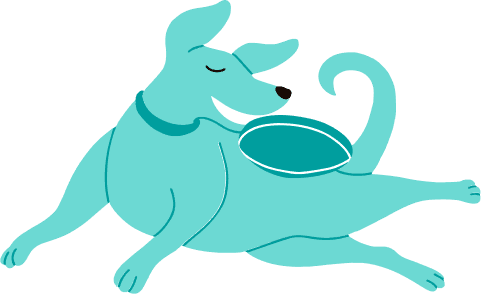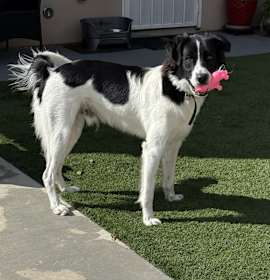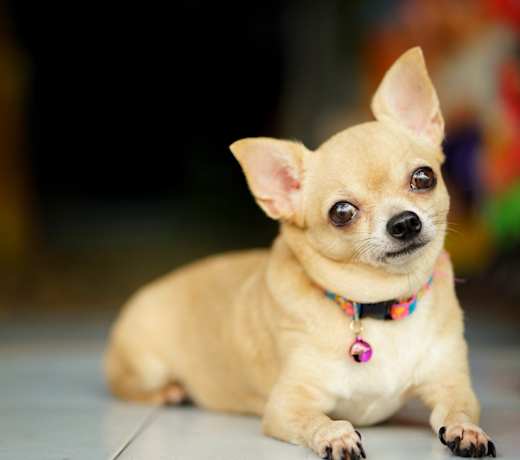Most Xolo dogs are extra-small and medium-sized dogs. The Toy Xoloitzcuintli are extra-small dogs, most weighing 10 to 15 pounds and standing 10 to 14 inches tall. The Miniature Xoloitzcuintli are small dogs, most weighing 15 to 30 pounds and standing 14 to 18 inches tall. The Standard Xoloitzcuintli are medium-sized dogs, most weighing 30 to 40 pounds and standing around 18 to 24 inches tall.
Xoloitzcuintli
Breed Type: Non-Sporting
Common nicknames: Xolo
Coat: Hairless, smooth
Hypoallergenic: Yes, they may not trigger allergies.
Temperament: Energetic, intelligent, loyal, eager-to-please
Life expectancy: 13-18 years
Color & patterns: Red

The Xoloitzcuintle may have a name that’s difficult to pronounce, but you’ll have no trouble falling in love with this unique breed. This breed, also known as the “Mexican Hairless,” is typically small to medium and size and, despite their name, sometimes has short, fine coats. Xolos make great companions for those with allergies as they are a less-allergenic breed. These dogs are intelligent, affectionate, and known for their loyalty to their pet parents. Xolos have been called “velcro dogs” for their tendency to stay close, and their calm and loving temperament makes them great family pets. They are also highly adaptable and can thrive in both apartment and house living.
Xoloitzcuintli characteristics
Learn about about Xoloitzcuintli basics like their fur colors, shedding levels, how much grooming they need, and other Xoloitzcuintli facts.
Average height
10-24 inches (25.4-61.0cm)
Average weight
10-40 pounds (4.5-18.1 kg)
Average lifespan
13-18 years
Grooming needs
Full-grown size
Good with cats
Training aptitude
Do Xoloitzcuintli have hair?
Yes, while Xoloitzcuintli are mostly hairless, they may have tufts of a short, smooth coat on their heads, feet, and sometimes their tails. While the Xolo has largely smooth skin, some have peach fuzz across their bodies.
Do Xoloitzcuintli shed?
No, the hairless Xoloitzcuintli does not shed, as they have very little hair. But like you, the hairless Xolo does need sunscreen in the summer, so don’t forget the SPF. Coated Xolos shed minimally. Shedding in Xoloitzcuintli, particularly in coated varieties, typically occurs year-round but may increase during seasonal changes.
What color are Xoloitzcuintli?
The Xoloitzcuintli is usually black or charcoal gray and almost always a solid color. There are varieties, however, including a bronze coat variety.
How long do Xolo dogs live?
Xoloitzcuintli dogs typically live for around 13 to 18 years, though with proper care, some may live even longer. As with any breed, factors such as genetics, diet, exercise, and overall healthcare play crucial roles in determining a Xolo’s lifespan.
How many types of Xolos are there?
There are several types of Xolo dogs: The Toy, Miniature, and Standard. The Miniature variety is the most popular. And while known as the “Mexican hairless” breed, there is actually a coated variety, too.
When do Xoloitzcuintlis stop growing?
Xoloitzcuintli dogs typically reach their full size and stop growing by the time they are around 12 to 18 months old. During the first year or so of their lives, Xolos will undergo significant growth and development, both in terms of size and physical maturity. After reaching adulthood, they will maintain their size and physical characteristics, although they may continue to fill out and mature mentally over the next few years.
How to pronounce Xoloitzcuintli?
“Xoloitzcuintli” is pronounced “show-low-eets-kweent-lee.” It is common to see their breed name shortened to “Xolo,” pronounced “show-low.” The meaning of the name Xoloitzcuintli comes from two words in the Nahuatl language: “Xolotl,” the god of death and lightning, whose appearance shares human and dog features, and “itzcuintli,” which means dog.
Are Xoloitzcuintli rare?
Yes, Xoloitzcuintli dogs are rare in the U.S. While they have gained popularity in recent years because of their hairless appearance and ancient heritage, they are still not as commonly seen as more mainstream breeds. The breed nearly went extinct until significant efforts were made in the 1950s to revive and help raise awareness of the breed.
Xoloitzcuintli history
Learn about where the Xoloitzcuintli came from.
Where are Xolos from?
The Xoloitzcuintli, also known as the “Xolo,” is a North American breed with deep roots in Mexico. It’s the oldest hairless dog breed and one of the most ancient dog breeds in general. Statues of these dogs have been uncovered in Mayan, Colima, and Aztec native tombs dating back over 3,500 years.
What were Xoloitzcuintli dogs bred for?
Xoloitzcuintli dogs were bred by the ancient Aztecs to heal and protect their families in life and death. These dogs were highly valued not only for their companionship but also for their perceived healing properties. Additionally, Xolos were used as watchdogs, alerting their pet parents to potential dangers. These dogs held a significant cultural and religious significance, often being buried alongside their human companions to guide them in the afterlife.
Xoloitzcuintli temperament
Learn about about the Xoloitzcuintli temperament and how well they fit into your lifestyle, home environment, and family.
Are Xolos good with kids?
Yes, Xolos are good with kids, but they are best with older children, with whom they can match their energy for play (as long as they're socialized early).
As with any breed, it is recommended that your child is always supervised when interacting with your Xoloitzcuintli to keep both the child and dog safe. Teaching children how to properly approach and handle dogs is crucial to ensure positive experiences for both the dog and the child, as is teaching dogs how to interact gently with children.
Are Xoloitzcuintli aggressive?
No, Xoloitzcuintli dogs are not aggressive, but like all breeds, their behavior can be influenced by factors such as genetics, socialization, training, and individual temperament. When raised in a loving and nurturing environment and properly socialized, Xolos are typically friendly, affectionate, and well-adjusted companions.
Are Xolos easy to train?
Yes, Xolos’ intelligence, loyalty, and eagerness to please their pet parents make them highly trainable. However, training any dog takes substantial time and effort, regardless of breed, and while Xolos are quick to learn tasks, behaviors, and commands, they are less biddable than other breeds and can sometimes be stubborn. They respond well to rewards and praise but might not be as motivated by commands without a clear purpose or reward. They need a confident, experienced trainer who will be gentle with this sensitive breed.
Do Xoloitzcuintlis bark a lot?
Yes, Xoloitzcuintli dogs are alert barkers. At home, Xolos may bark in response to perceived threats, unfamiliar noises, or visitors approaching the door, as they may be wary of strangers. As with any dog, proper training and exercise can discourage barking as frequently.
Are Xoloitzcuintli good dogs?
Yes, the Xoloitzcuintli is a good dog for the right family. They are a high-energy breed that requires a lot of mental and physical stimulation, and they are also extremely devoted to their people. This is not a dog that can be left alone most of the time; they love to be around their humans, and they love having other dogs in the home.
Are Xolos good with cats?
Yes, Xoloitzcuintli can be good with cats. Gradually introducing them in a controlled environment can help mitigate any potential chasing behavior and foster a positive relationship between them. Of course, each dog (and cat) has their own preferences and temperament, but you can feel fairly confident your Xoloitzcuintli, if properly socialized to your cat and/or introduced at a young age, should get along just swell.
Are Xoloitzcuintlis good with other dogs?
Yes, Xoloitzcuintlis can be good with other dogs, but it largely depends on their socialization and training. They tend to be more reserved and may take some time to warm up to new canine friends. Their aloofness doesn’t necessarily mean they are unfriendly; it simply reflects their cautious nature. Xolos can be playful and affectionate with dogs they know and trust. Positive reinforcement, patience, and consistent training will help them feel more comfortable and confident around other dogs.
Are Xoloitzcuintli smart?
Yes, Xoloitzcuintli are smart dogs. This can sometimes mean that they find creative ways to get what they want, such as figuring out how to access food or toys, finding escape routes, or manipulating their people for attention or treats. On the bright side, they can excel in various activities, including obedience, agility, and even therapy work.
Are Xoloitzcuintli good guard dogs?
Yes, Xoloitzcuintli dogs can make good guard dogs as they are keen observers. However, their suitability for this role can vary depending on individual temperament and training. Additionally, positive reinforcement training methods should be used to ensure that the Xolo’s guarding behaviors are appropriate and well-controlled.
Xoloitzcuintli health
Learn about about the Xoloitzcuintli health outlook and what diseases they may be prone to at various stages of their life.
Do Xolos have a lot of health problems?
No, Xolos are unlikely to have a lot of health problems. Like most ancient breeds, thousands of years of natural selection have led to them being overall a very healthy breed with few serious disorders.
What diseases are Xolos prone to?
Xolos may be prone to some health conditions, including:
Dental issues: The traits for hairlessness and missing teeth are genetically linked, so the hairless variety of this breed often has some missing teeth.
Skin issues: Xolos are prone to acne, sunburns, and dryness. Protect your dog with SPF just as you would yourself!
Are Xoloitzcuintli hypoallergenic?
Yes, Xoloitzcuintli dogs are often considered hypoallergenic because of their unique hairless coat, although individual reactions can vary. People with dog allergies may find that they have fewer allergic reactions to Xolos compared to other breeds with more traditional fur coats.
However, they are not entirely hypoallergenic. Allergies are typically triggered by proteins found in a dog’s saliva, dander, and urine rather than just their fur. Some individuals with dog allergies may still experience reactions to Xoloitzcuintli dogs.
Do Xoloitzcuintli drool?
No, Xoloitzcuintlis are not known for being heavy droolers. If you see excessive drooling, it could be a sign of dental issues, an upset stomach, or something stuck in their mouth, so it’s a good idea to check with your vet.
Do Xoloitzcuintli smell?
No, Xolos do not smell when they are clean and healthy. Their lack of a traditional fur coat means that they may not trap as much dirt and odor as some other breeds with denser coats.
Popular Xoloitzcuintli mixes
Not many breeds are commonly mixed with Xoloitzcuintli. The most common Xolo mixes include:
Mexican Hairless Chihuahua (Xoloitzcuintli + Chihuahua)

Find Xoloitzcuintli puppies near you
Adopting a Xoloitzcuintli
Learn about acquiring a Xoloitzcuintli - the pros and cons of adopting versus going through a breeder, and associated costs.

Bandit
Xoloitzcuintle/Mexican Hairless Airedale Terrier
Male, young
Inglewood, CA
Good with dogs
Good with cats
House-trained
Shots are up-to-date

Bandit
Xoloitzcuintle/Mexican Hairless Airedale Terrier
Male, young
Inglewood, CA
Good with dogs
Good with cats
House-trained
Shots are up-to-date




